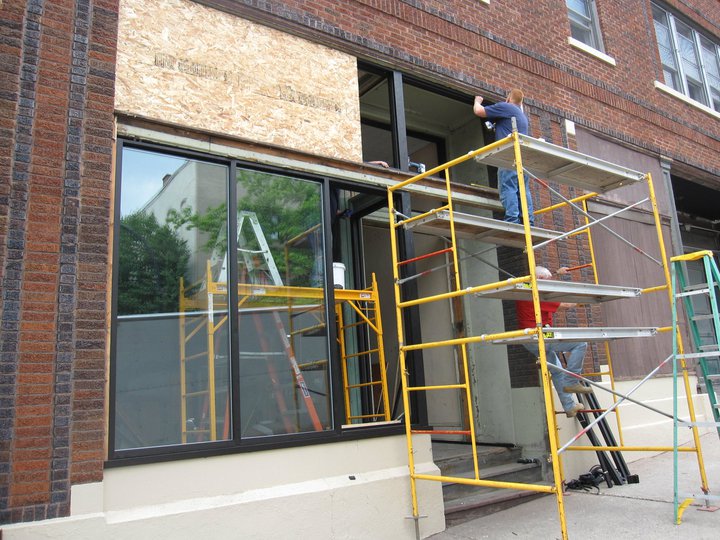Renovating an old building isn’t easy. Outdated electrical systems, inefficient windows, an attic full of pigeon droppings – these and many other problems are expensive barriers to the revitalization of buildings in our cities and villages.
This is why starting from scratch is often so appealing. Just build something new on an empty piece of land and you avoid the headaches that come with redevelopment. But over time, as many people make this seemingly rational choice, a series of unintended consequences – including abandonment and sprawl – combine to produce higher public costs and a weaker tax base.
Changing this equation by making renovation a more financially feasible and competitive option should be the goal for any region looking to control costs while also making established downtowns and neighborhoods more vibrant.
In downtown Jamestown, strides have been made in recent years to do just that. Grant programs through the Jamestown Renaissance Corporation and City of Jamestown have assisted numerous property owners with costly renovation projects that otherwise would have been impossible. And with the recent listing of over 100 downtown properties to the National Register of Historic Places, access to state and federal tax credits have been added to an extensive revitalization toolkit.
But as extensive as that toolkit is, there’s an important tool that’s currently going unused. It’s called Section 485-A of New York’s Real Property Tax Law – a provision that aids in the conversion of non-residential properties to a mixture of commercial and residential uses.
Here’s how it works: if a qualifying building is converted into a mixed-use property, the owner would pay property taxes on the pre-renovation assessed value for a period of eight years. The property’s taxable value would then increase gradually through year 13, when the property owner would pay taxes on the full, post-renovation assessed value.
On a costly and risky rehab, the tax savings enabled by the Section 485-A incentive can be the difference between a project that makes financial sense and one that doesn’t. A great example of a project that would benefit from this incentive recently took place in downtown Jamestown.
There, the JRC worked with a developer to evaluate the feasibility of converting a property to mixed-use. The project would have involved the purchase of a dilapidated three-story building for $20,000, with plans to create two upper-floor apartments and two ground-level storefronts. After renovation, the building’s assessed value was predicted to climb to $300,000, reflecting its true market value. The cost to complete the proposed renovation: $554,000.
If left to the developer and their own resources, the project wouldn’t add up. That’s where incentives enter the picture. Through a combination of owner equity, a bank loan, federal and state historic tax credits, Community Development Block Grants through the City of Jamestown, and a grant from the JRC, the $554,000 price tag would be met. Grants and tax credits would equal 50% of the project cost.
But even if half of the project were covered by grants and tax credits, would it make sense for the developer without any form of property tax exemption? Not really. In the first year of operation, the difference between revenues like rental income and costs like taxes, maintenance, insurance, and debt service would leave the owner with a projected loss of $450. That loss would gradually turn into a yearly gain, but a gain amounting to just $4,600 in year 10. As any property owner would likely tell you, pursuing the renovation wouldn’t have been worth the risk.
But with a Section 485-A incentive, the project makes sense – and that’s why it’s important to include this tool in our property rehabilitation toolkit. By using the building’s pre-renovation value of $20,000 to determine property taxes, the first year loss of $450 would turn into a first year profit of $13,800. The profit would rise to $17,400 by year eight and then begin to drop as the incentive tapers off.
In this example, having the Section 485-A incentive wouldn’t create a windfall for the developer – but it would provide a period to stabilize occupancy, build equity, and make a small return. In short, it turns a project that doesn’t make much sense into one that’s feasible. And by enacting this incentive, Jamestown would be offering property owners an important tool that could be used to improve the feasibility of projects that, in turn, have the potential to expand the city’s long-term tax base and economic viability.
Many communities in New York State, large and small, have already adopted the Section 485-A incentive since its passage by the state legislature in 2002. These include the cities of Batavia, Auburn, and Cohoes, as well as Niagara, Onondaga, and Oswego counties. If this tool is to have maximum impact, it would need to be adopted by a city, by its county, and by its school district.
It’s an option Jamestown’s City Council, the county legislature, and the Jamestown City School District should seriously consider. Any property owner will tell you that rehabilitation is a matter of having the right tool for the right job. Implementing the Section 485-A incentive would provide access to that tool and invigorate downtown revitalization.
–Greg Lindquist and Peter Lombardi
This post originally appeared in The Post-Journal on January 19, 2015, as the JRC’s biweekly Renaissance Reflections feature.

